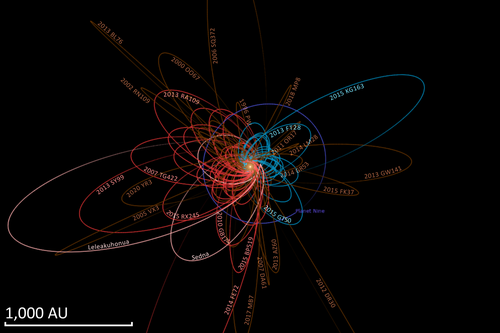 The orbits of some of the most distant minor planets, 2013 BL76 at top left | |
| Discovery [1] [2] [3] | |
|---|---|
| Discovered by | Mt. Lemmon Survey |
| Discovery date | 20 January 2013 |
| Designations | |
| 2013 BL76 | |
| Orbital characteristics [1] | |
| Epoch 4 September 2017 (JD 2458000.5) | |
| Uncertainty parameter 1 | |
| Observation arc | 1.88 yr (687 days) |
| Aphelion | |
| Perihelion | 8.3622 AU |
| |
| Eccentricity | 0.9923 |
| 0.0493° | |
| 0° 0m 0s / day | |
| Inclination | 98.613° |
| 180.20° | |
| 165.96° | |
| Physical characteristics | |
| Dimensions | |
| 22.1 [7] | |
| 10.8 [1] [5] | |
(709487) 2013 BL76 is a trans-Neptunian object and centaur [4] from the scattered disk and Inner Oort cloud approximately 30 kilometers in diameter.
Contents
- Possible comet
- Orbit
- Comparison
- Largest semimajor axes of minor planets
- Notes
- References
- External links
Using an epoch of February 2017, it is the minor planet with the 5th largest heliocentric semi-major axis in the Solar System (larger ones include 2014 FE72 , 2012 DR30 , and 2005 VX3 ). [8] 2013 BL76 has a barycentric semi-major axis of ~964 AU, [9] [a] which is the third largest barycentric semi-major axis of any minor planet.
